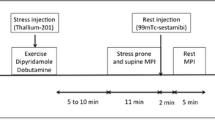Abstract
Retrospective analyses of the stress thallium studies of 51 patients with a history of previous infarctions or definite stable angina were performed in order to determine the extent of the coronary-artery disease (CAD). The results were correlated with recent coronary-angiography findings in order to assess the effect of including rightventricule (RV) visualization on the accuracy of the detection of right coronary-artery (RCA) disease, as well as the effect of graded stenosis or occlusion of the RCA and the presence of disease of the other coronary vessels on the visualization of the RV. Eight patients had normal coronary arteries. The other 43 patients had CAD, only 5 of whom had single-vessel RCA disease. With regard to the RV, 6 patients had nonvisualization, 30 had patchy visualization, and 15 had normal visualization in the stress thallium studies. Nonvisualization indicated 100% occlusion of RCA in 6 out of 6 patients. Patchy visualization indicated significant occlusion of the RCA in 25 out of 30 patients (83%), while normal visualization indicated a normal RCA in 13 out of 15 patients (86%). Normal visualization did not mean that the possibility of RCA disease could be excluded. When RV visualization data were added to LV images, the sensitivity for detecting RCA increased from 66% to 94% (P<0.05), the specificity decreased from 89% to 72% (P<0.1), and the predictive accuracy increased from 75% to 86% (P>0.1).
Similar content being viewed by others
References
Brown KA, Boucher CA, Okada RD, Strauss HW, McKusick KA, Pohost GM (1982) Serial right ventricular thallium-201 imaging after exercise: Relation to anatomy of right coronary artery. Am J Cardiol 50:1217–1222
Bruce CA (1971) Exercise testing of patients with coronary heart disease: principle and normal standards for evaluation. Ann Clin Res 3:323–332
Cohen HA, Baird MC, Rouleau JR, Fuhrman CF, Baily IK, Summer WR, Strauss HW, Pitt B (1976) Thallium 201 myocardial imaging in patients with pulmonary hypertension. Circulation 54:790–795
Cook DJ, Bailey I, Strauss HW, Rouleau J, Wagner HN Jr., Pitt B (1976) Thallium-201 for myocardial imaging appearance of the normal heart. J Nucl Med 17:583–589
Gutman J, Brachman M, Rozanski A, Maddahi J, Waxman A, Berman DS (1983) Enhanced detection of proximal right coronary artery stenosis with additional analysis of right ventricular thallium-201 uptake in stress scintigrams. Am J Cardiol 51:1256–1260
Kondo M, Kubo A, Yamazaki H, Handa S, Tsugu T, Masaki H, Kinoshita F, Hashimata S (1978) Thallium-201 myocardial imaging for evaluation of right ventricular overloading. J Nucl Med 19:1197–1203
Lavy MN, Marthins de Olivera J (1961) Regional distribution of myocardial blood flow in the dog as determined by 36Rb, Circ Res 9:96–98
McNeil BJ, Keeler E, Adelstein SJ (1975) Primer on certain elements of medical decision making. N Engl J Med 293:211–215
O'Brien PC, Shampo MA, Robertson JS (1983) Statistics for nuclear medicine, pt 3A. Comparing two proportions (the relative deviate test and chi-square equivalent). J Nucl Med 24:269–272
Ohsuzu F, Handa S, Kondo M, Yama-Zaki H, Tsugu T, Kubo A, Takagi Y, Nakamina Y (1980) Thallium-201 myocardial imaging to evaluate right ventricular overloading. Circulation 61:620–625
Pitt A, Friesinger GC, Ross RS (1969) Measurements of blood flow in the right and left coronary beds in humans and dogs using the xenon-133 technique. Cardiovasc Res 3:100–106
Rigo P, Bailey IK, Griffith LSC, Pitt B, Wagnar HN, Becker LC (1981) Stress thallium-201 myocardial scintigraphy for the detection of individual coronary arterial lesion in patients with and without previous myocardial infarction. Am J Cardiol 8:209–216
Strauss HW, Harrison K, Langan JK, Lebowitz E, Pitt B (1975) Thallium-201 for myocardial imaging. Relation of thallium-201 to regional myocardial perfusion. Circulation 51:641–645
Zir LM, Miller SW, Dinsmore RE, Gilbert JP, Harthorne JW (1976) Interobserver variability in coronary angiography. Circulation 53:627–632
Author information
Authors and Affiliations
Rights and permissions
About this article
Cite this article
Bahar, R.H., Hassan, I.M., Mohammed, M.M. et al. Detection of right-coronary-artery disease using stress thallium scintigraphy: Importance of considering the right ventricle. Eur J Nucl Med 11, 336–340 (1986). https://doi.org/10.1007/BF00253297
Received:
Published:
Issue Date:
DOI: https://doi.org/10.1007/BF00253297




